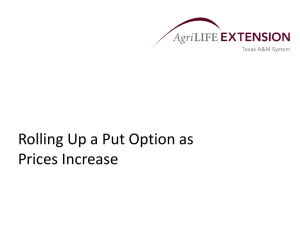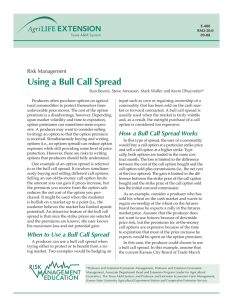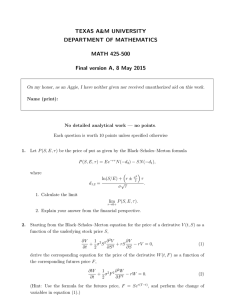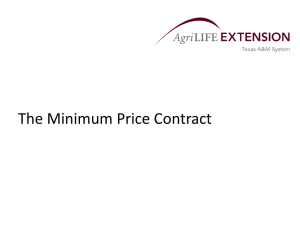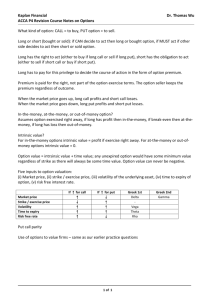Rolling Up a Put Option as Prices Increase Risk Management
advertisement
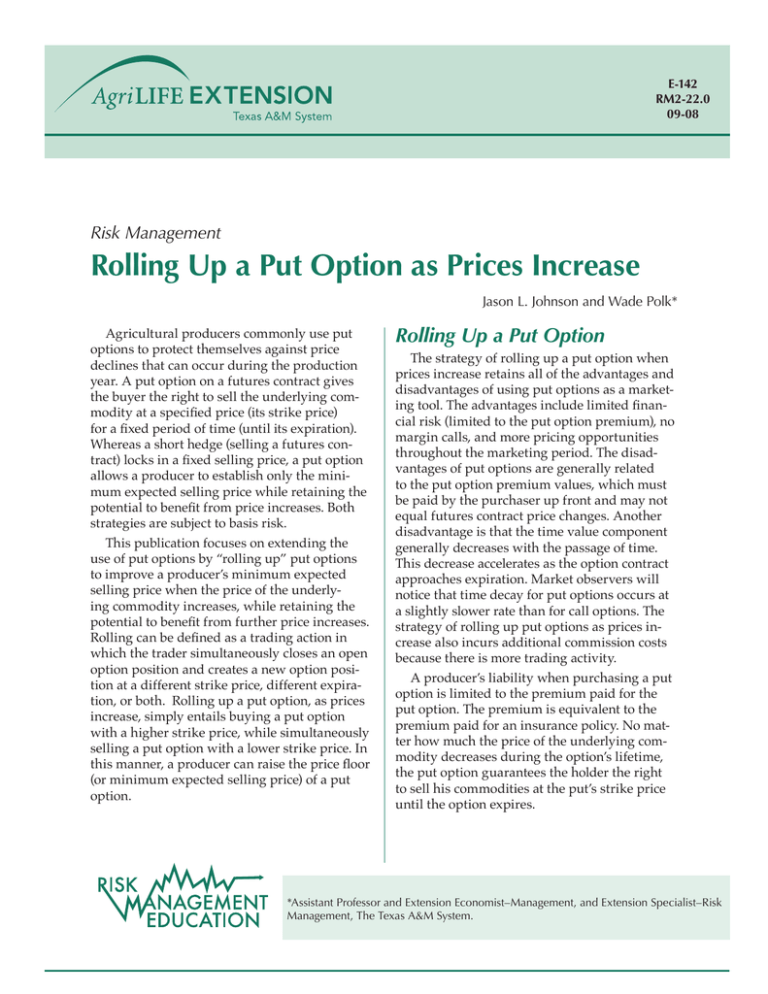
E-142 RM2-22.0 09-08 Risk Management Rolling Up a Put Option as Prices Increase Jason L. Johnson and Wade Polk* Agricultural producers commonly use put options to protect themselves against price declines that can occur during the production year. A put option on a futures contract gives the buyer the right to sell the underlying commodity at a specified price (its strike price) for a fixed period of time (until its expiration). Whereas a short hedge (selling a futures contract) locks in a fixed selling price, a put option allows a producer to establish only the minimum expected selling price while retaining the potential to benefit from price increases. Both strategies are subject to basis risk. This publication focuses on extending the use of put options by “rolling up” put options to improve a producer’s minimum expected selling price when the price of the underlying commodity increases, while retaining the potential to benefit from further price increases. Rolling can be defined as a trading action in which the trader simultaneously closes an open option position and creates a new option position at a different strike price, different expiration, or both. Rolling up a put option, as prices increase, simply entails buying a put option with a higher strike price, while simultaneously selling a put option with a lower strike price. In this manner, a producer can raise the price floor (or minimum expected selling price) of a put option. Rolling Up a Put Option The strategy of rolling up a put option when prices increase retains all of the advantages and disadvantages of using put options as a marketing tool. The advantages include limited financial risk (limited to the put option premium), no margin calls, and more pricing opportunities throughout the marketing period. The disadvantages of put options are generally related to the put option premium values, which must be paid by the purchaser up front and may not equal futures contract price changes. Another disadvantage is that the time value component generally decreases with the passage of time. This decrease accelerates as the option contract approaches expiration. Market observers will notice that time decay for put options occurs at a slightly slower rate than for call options. The strategy of rolling up put options as prices increase also incurs additional commission costs because there is more trading activity. A producer’s liability when purchasing a put option is limited to the premium paid for the put option. The premium is equivalent to the premium paid for an insurance policy. No matter how much the price of the underlying commodity decreases during the option’s lifetime, the put option guarantees the holder the right to sell his commodities at the put’s strike price until the option expires. *Assistant Professor and Extension Economist–Management, and Extension Specialist–Risk Management, The Texas A&M System. A producer using put options on agricultural futures contracts retains all benefits of commodity ownership during the lifetime of the put option and has “insured” the value of production against a decrease in value during the lifetime of the put. If the producer loses concern over a possible price decline, and the put option has market value remaining, the option may be sold. If the put option expires with no value, no action need be taken; the producer will simply market the commodity at a price at or above the minimum expected selling price. If the option expires in-the-money (futures price closes below the put option strike price), the producer can exercise the right to sell the underlying commodity at the put’s strike price. Alternatively, the producer may sell the put option, if it has market value, before the market closes on the option’s last trading day. The premium received from the put option’s sale will offset any financial loss from a decline in the value of the underlying commodity. The put option is a viable risk management strategy because it limits and predefines the downside market risk. futures contract is trading at $8.00 per bushel. Further, a July wheat put option with an $8.00 strike price is trading for a premium of $0.75 per bushel. This put option premium has no intrinsic value; the time value amounts to $0.75 per bushel. Action: Buy an $8.00 (strike price) put option, which establishes a minimum expected selling price (MESP #1) of $6.23 per bushel. MESP #1 = $8.00 - $0.75 - $0.02 - $1.00 = $6.23 Scenario 1 — Wheat Prices Decrease If wheat prices decrease from the initial level, the put option will gain intrinsic value as the $8.00 per bushel strike price implies an in-themoney position. The remaining time value of the put option will be determined by the amount of time remaining until the put option expires. If the July wheat futures contract were trading at $7.00 per bushel at expiration, the producer would receive approximately $1.00 per bushel from the put option ($8.00 strike price minus $7.00 futures). The Minimum Expected Selling Price Selling price of wheat at local delivery location: With options, you can tailor your position to your own financial situation, commodity market outlook, and risk tolerance. The minimum expected selling price (MESP) established with the purchase of a put option can be calculated as: +Realized gain from put option: - Put option premium: MESP = Strike Price - Put Option Premium Commissions and Interest ± Expected Basis Higher strike prices for put options command higher premiums. Therefore, a producer can choose a strike price that balances the desire for an acceptable price floor with the required premium that must be paid for this price insurance. Let’s examine the consequences of rolling up put options for downside price risk management. The first action is buying a put option. Assume an expected basis of $1.00 per bushel under the futures price, and commission and interest charges of $0.02 per bushel for each trade. Assume that in September, the July wheat - Commission and interest: $6.00 per bushel ($7.00 per bushel - $1.00 basis) +$1.00 per bushel - $0.75 per bushel - $0.02 per bushel Result: The effective selling price of $6.23 per bushel (subject to basis risk) is equal to the minimum expected selling price established with the put option. Thus, the put option gave protection from declining prices. 2 Scenario 2 — Wheat Prices Increase (Rolling a Put Option Up as Price Increases) Suppose that in February, the July wheat futures contract has increased to $9.00 per bushel. A July wheat put option with an $8.00 strike price is trading for a premium of $0.08 per bushel and the July wheat put option with a $9.00 strike price is trading for a premium of $0.65 per bushel. Action: Sell the $8.00 put option for $0.08 per bushel and buy the $9.00 put option to increase the minimum expected selling price (MESP #2) to $6.64 per bushel. chased for $0.15 per bushel and buy the $9.70 put option to increase the minimum expected selling price (MESP #3) to $7.02 per bushel. MESP #3 = strike price - net premium paid commissions and interest ± basis MESP #3 = $9.70 - $1.62 - $0.06 - $1.00 = $7.02 Net premium paid = premiums paid - premium received Net premium paid = ($0.75 for $8.00 put + $0.65 for $9.00 put + $0.45 for $9.70 put) - ($0.08 from sale of $8.00 put + $0.15 from sale of $9.00 put) = $1.62 MESP #2 = strike price - net premium paid commissions and interest ± basis Result: Rolling up the put option again allows the producer to raise the price floor, or minimum expected selling price, to $7.02 per bushel, an increase of $0.38 per bushel above the $6.64 per bushel (MESP #2) established with the purchase of the $9.00 strike price put option. If prices decline from this point, the producer can expect to receive no less than $7.02 per bushel subject to basis risk. This scenario illustrates the concept of rolling up put options to raise the minimum expected selling price when the price of the underlying commodity increases over time. Taking advantage of increasing prices is an opportunity agricultural producers would hope to have each year. Unfortunately, when it does occur, they often fail to capitalize on the situation. The strategy of rolling up a put option allows a producer to benefit from increasing prices. MESP #2 = $9.00 - $1.32 - $0.04 - $1.00 = $6.64 Net premium paid = premiums paid - premium received Net premium paid = $1.32 ($0.75 for $8.00 put + $0.65 for $9.00 put - $0.08 from sale of $8.00 put) Result: Rolling up the put option allows the producer to raise the price floor, or minimum expected selling price, to $6.64 per bushel, an increase of $0.41 per bushel above the $6.23 per bushel (MESP #1) established with the purchase of the initial $8.00 strike price put option. If prices decline from this point, the producer can expect to receive no less than $6.64 per bushel subject to basis risk. Suppose that in April, the July wheat futures contract has increased again to $9.70 per bushel. A July wheat put option with a $9.00 strike price is trading for a premium of $0.15 per bushel and the July wheat put option with a $9.70 strike price is trading for a premium of $0.45 per bushel. Notice that the at-the-money put option now trades for a smaller premium because the time value of the put option has decayed as the contract approaches expiration. Action: Sell the $9.00 put option previously pur- 3 Appropriate Uses of this Strategy One final issue to keep in mind is the timing and frequency of rolling up put options to capitalize on price increases of commodities. Since the premise of this strategy is to raise the minimum expected selling price, producers should allow the price of the underlying commodity to increase more than the net premiums required to roll up the put option plus the added commission and interest expenses. Otherwise, producers would simply incur additional trading expenses without raising their minimum expected selling price. An agricultural producer who uses a put option marketing strategy typically produces the underlying commodity, but is concerned about possible market risks. The primary motivation of the producer is to protect the value of the commodity from a decrease in market price. The quantity of production covered with a put option contract is identical to the quantity specified in the underlying futures contract. A put option can be purchased to protect all or a portion of a producer’s expected or insured level of production. This strategy enables the producer to choose the most appropriate time to sell or contract the commodity. If there is a sudden, significant decrease in the market price, a put owner has the luxury of time to react. Partial funding support has been provided by the Texas Corn Producers, Texas Farm Bureau, and Cotton Inc.–Texas State Support Committee. Produced by AgriLife Communications, The Texas A&M System Extension publications can be found on the Web at: http://AgriLifeBookstore.org. Visit Texas AgriLife Extension Service at http://AgriLifeExtension.tamu.edu. Educational programs of the Texas AgriLife Extension Service are open to all people without regard to race, color, sex, disability, religion, age, or national origin. Issued in furtherance of Cooperative Extension Work in Agriculture and Home Economics, Acts of Congress of May 8, 1914, as amended, and June 30, 1914, in cooperation with the United States Department of Agriculture. Edward G. Smith, Director, Texas AgriLife Extension Service, The Texas A&M System.
